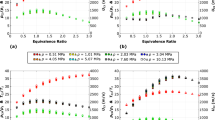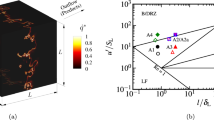Abstract
To obtain an ultralean air-fuel ratio and to reduce engine-out NOX and HC emissions induced by the richer mixture near the spark plug, a spray and wall complex guided combustion system has been developed by utilizing the fuel characteristics of LPG. The new combustion system configuration is optimized by using a commercial CFD code, FIRE V2013, and the reliability of the system has been experimentally demonstrated by Plane Laser-Induced Fluorescence (PLIF). The mixture formation in the new combustion system under part load (2,000 rpm) is numerically simulated. With an injection timing of 40°CA BTDC, the LPG spray which is injected from two upper holes, reaches the ignition point, and the other part of the LPG spray which is injected from the bottom hole, is directed to the ignition point through the vertical vortices at the same time. At the ignition timing of about 20°CA BTDC, the two-part mixtures have been shown to form a stable and richer stratified mixture around the ignition point, and the maximum global air-fuel ratio reaches to 60: 1.
Similar content being viewed by others
Abbreviations
- LPG:
-
liquefied petroleum gas
- CFD:
-
computational fluid dynamics
- GDI:
-
gasoline direct injection
- BTDC:
-
before top dead center
- BDC:
-
bottom dead center
- SMD:
-
sauter mean diameter
References
AVL List GmbH (2013). Fire User Manual. Version 2013.
Boretti, A. A. and Watson, H. C. (2009). Development of a direct injection high efficiency liquid phase LPG spark ignition engine. SAE Paper No. 2009-01-1881.
Da Costa, R., Gomes, C., Franco, R., Guzzo, M., Franco, R., Guzzo, M. and Pujatti, F. (2015). E100 stratified lean combustion analysis in a wall-air guided type GDI optical engine. SAE Paper No. 2015-36-0269.
GB 19159-2003 (2003). China Standards Press. Beijing, China.
Kim, S. J., Kim, Y. N. and Lee, J. H. (2008). Analysis of Figure 15. Velocity distribution at 2,000 rpm. the in-cylinder flow, mixture formation and combustion processes in a spray-guided GDI engine. SAE Paper No. 2008-01-0142.
Lee, J. W., Do, H. S., Kweon, S. I., Park, K. K. and Hong, J. H. (2010). Effect of various LPG supply systems on exhaust particle emission in spark-ignited combustion engine. Int. J. Automotive Technology 11, 6, 793–800.
Ma, Z. Z., Qi, Y. L. and Xu, B. Y. (2007). Research on LPG spray for liquid phase injection system. J. Shandong Jianzhu University 22, 2, 131–135.
Mesman, P. H. and Veenhuizen, B. (2009). The spray behavior of liquid LPG at different back pressures during injection in a constant volume chamber. SAE Paper No. 2009-01-1834.
Ozcan, H. and Yamin, J. A. A. (2008). Performance and emission characteristics of LPG powered four stroke SIengine under variable stroke length and compression ratio. Energy Conversion and Management 49, 5, 1193–1201.
Sarikoc, F., Kettner, M., Velji, A., Spicher, U., Krause, A. and Elsaesser, A. (2006). Potential of reducing the NOx emissions in a spray guided DI gasoline engine by stratified exhaust gas recirculation (EGR). SAE Paper No. 2006-01-1261.
Schwarz, C., Schünemann, E., Durst, B., Fischer, J. and Witt, A. (2006). Potentials of the spray-guided BMW DIcombustion system. SAE Paper No. 2006-01-1265.
Shao, Q. J., He, W. H., Zhou, W. H., Liu, H. W., Luan, Y. M. and Xu, H. (2003). Experimental study of intake liquid injection of LPG-fueled engine. Trans. CSICE 21, 1, 65–68.
Technics and Chemical Industry Institute (1974). Engineer Institute of German Federal Republic. Heat Transfer Manual. Chemical Industry Press. Beijing, China.
Xu, B. Y., Geng, D. Q., Qi, Y. L., Liu, H. Y. and Cai, S. L. (2009). Simulation and visualization of liquid phase LPG spray. Trans. CSICE 27, 2, 146–152.
Xu, J. (2009). Theoretical Research on the Mixture Formation for a Low Pressure Direct Injection LPG Engine. M. S. Thesis. Shandong Jianzhu University. Jinan, China.
Yamamoto, S., Tanaka, D., Takemura, J., Nakayama, O. and Ando, H. (2001). Mixing control and combustion in gasoline direct injection engines for reducing cold-start emissions. SAE Paper No. 2001-01-0550.
Yang, S. C., Li, J. and Li, D. G. (2007). Analysis on development for gasoline direct injection technology. Vehicle Engine 5, 171, 8–13.
Yaws, C. L. (2003). Matheson Gas Data Book. 7th edn. Chemical Industry Press. Beijing, China.
Zheng, J., Zhan, Z., Shen, H., Li, X., Xu, Z., Tang, Y., Chen, X., Zeng, Q., Qing, H. and Hu, T. (2016). Simulation guided design for developing direct injection combustion systems of gasoline engines. SAE Paper No. 2016-01-2313.
Author information
Authors and Affiliations
Corresponding author
Rights and permissions
About this article
Cite this article
Xu, By., Liu, Xl., Jiang, Ll. et al. Simulation of mixed gas formation for a spray-wall complex guided LPG direct injection engine. Int.J Automot. Technol. 18, 489–497 (2017). https://doi.org/10.1007/s12239-017-0048-y
Received:
Revised:
Accepted:
Published:
Issue Date:
DOI: https://doi.org/10.1007/s12239-017-0048-y




